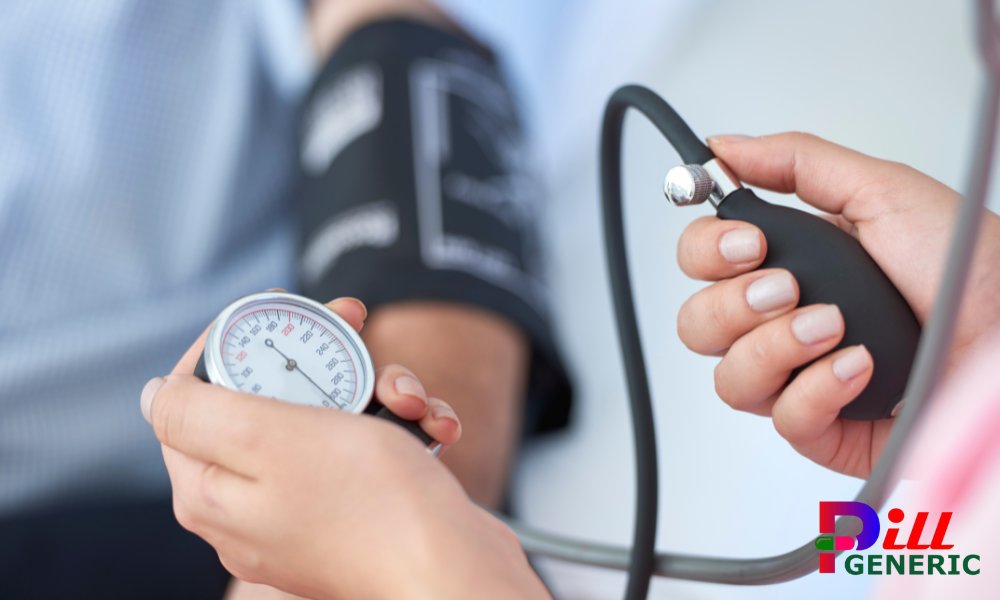Understanding Heart Rate
Your resting heart rate is known as your pulse rate.
Again, the normal heart rate may differ between the individuals based on their fitness level, medications, etc. However, most of the people are between 60 and 100 beats per minute.
Activities such as exercise or even fright can raise your heart rate for a short period of time. It’s normal as long as it doesn’t get too high.
When you finish your exercise or discover that you are not threatened by any danger, your heart rate returns back to the basal level.
Understanding Blood Pressure
Blood pressure is the pressure that your blood puts on the walls of your blood vessels as it fills them in.
A blood pressure reading is a pair of numbers such as 118/79 (read as “118 over 79”). The top or systolic number is the pressure that is applied as your heart beats, whereas the bottom or diastolic number is the pressure in between the beats.
It is therefore very important to ensure that your blood pressure remains within the range prescribed for your age and also gender.
High blood pressure can cause a lot of damage to your blood vessels, heart, brain, and also other organs if it is too high. If it is too low, you may not receive enough blood supply to the vital organs and areas, including the brain.
The “normal” blood pressure that is appropriate for you as an individual is a function of numerous factors and is subject to change if the latest medical research dictates.
But to give you a rough idea, doctors have historically referred to 120/80 as “normal.” The newer advice suggests lower readings than that.

Does the Heart Rate Affect the Blood Pressure?
Your heart rate and the blood pressure do not necessarily increase at the same rate. You can increase your heart rate by up to two times the normal rate without an increase in the blood pressure.
Indeed, even when your heart rate exceeds the normal rate, the normal blood vessels can also expand for a more efficient blood flow.
For example, when you exercise, your heart rate goes up and the more blood flows to your muscles.
Other than physical activities, your heart rate may also be influenced by the air temperature, your emotional state, the position of your body, your body size and also medication use.
What is this ‘Resting Heart Rate’?
This is not the same as your blood pressure, of course. Dr. Janushe Patel, one one of the doctors at Forward in San Francisco, states that “your resting heart rate is basically just what it sounds like.”
“ It’s the number of times your heart beats per minute when you are not exercising it, i.e. resting. In a normal resting heart rate, the number should be between 60 to 100 beats per minute.
However, when you are undergoing a lot of stress, anxiety and hormonal imbalances or taking some medications, then the number can vary.”
However, it is not only stress and your meds that can change your pulse. As the American Heart Association (AHA) reports, weight, body position, and even the air temperature can result in changes in the heart rate.
And, of course, there is also exercise as well which is the most apparent factor influencing how quickly — or even how slowly — your heart beats.
Patel adds, “A person with a very high level of physical activity can easily have a very low resting heart rate.” “It can be as low as forty beats per minute, and that is actually very, very common.”
So what Then, What Does blood pressure Indicate?
If heart rate is the frequency of your heart beats, then the blood pressure is the force generated by those heart beats.
As Patel explains, blood pressure is the pressure of the blood that flows through your blood vessels in a given second.
There are two types of measurements: Systolic and diastolic pressure.
According to the AHA, systolic pressure is the pressure your blood exerts on the artery walls during the heart’s beat; diastolic pressure is the pressure your blood exerts on the artery walls while the heart is at rest between the beats.
What is a normal blood pressure, then? It is best to have a systolic pressure of less than 120, and also a diastolic pressure of less than 80.
However, if you are past that, don’t panic says Patel.
At Forward, we follow the Joint National Committee (JNC) guidelines, and they indicate that, if you’re under 65, you only really need to start on medication to treat high blood pressure if your BP is higher than 140 over 90 — otherwise there are some simple changes you can make to your lifestyle to lower your blood pressure naturally.”
Blood Pressure vs. Heart Rate: Learn the Differences
Blood pressure and heart rate do not always go hand in hand; therefore, the pulse is not usually a very reliable indicator of either high or low blood pressure.
A fast heart rate does not necessarily mean that your blood pressure (BP) will rise at the same rate.
The majority of misconceptions about BP and heart rate readings arise since the two are usually taken simultaneously by the doctors and devices used by the people at home.
Confusion between the two readings is usually resolved among the patients who need to measure their blood pressure often, according to Curtis Hamburg, M.D., a cardiologist with Miami Cardiac & Vascular Institute and also a member of the Baptist Health Quality Network.
These patients often take the medications for BP control or have other risk factors for the heart disease.
“Most people who begin measuring their BP become convinced that the BP and HR do not correlate,” Dr. Hamburg said.
““Some of the drugs used in the treatment of hypertension (high blood pressure) have the effect of reducing or increasing the heart rates. Therefore, we instruct some patients to record both the values during the day.
Checking your heart rate:
Physical activity enables the heart to stay very healthy. While exercising one should periodically check the heart rate.
If you own a smart watch or any other wearable activity tracker, it should be very easy to ensure that your heart rate is within the target zone, or else you can do it manually.
Locate your pulse by placing the tips of your first two fingers over the artery found on the inside of your wrist. Press gently, count the beats for thirty seconds and then multiply the number by two in order to find your beats per minute.
If your heart rate is too high, then reduce the level of your training, and if it is a little low, you may want to increase the intensity slightly. If you are a beginner, you should start with the lower end of the your target zone and slowly move upwards.
What Is the Normal Blood Pressure Level?
While your blood pressure varies throughout the day based on the intensity of your activities, your doctor may diagnose you with high blood pressure, also known as hypertension, if your blood pressure is consistently higher than the normal levels. Having a higher blood pressure may increase your risk for conditions such as heart attack, heart disease and/or stroke. Read this article to understand more about your blood pressure numbers.
Heart rate, blood pressure and the physical activity
Your target heart rate is determined by the age and can serve as an important indicator of exercise intensity.
If you take your pulse before, during, and after physical activity, you will see that the heart rate will rise as the the exercise progresses.
It is to increase the blood flow to the deliver oxygen to the muscles that are working. The diastolic blood pressure will also elevate with the rise in your heart rate.
The higher the intensity of the exercise, the higher your heart rate will rise up.When you stop working out, your heart rate does not go back to your normal resting heart rate right away.
The less fit you are, the longer it is likely to take for your heart rate to return to the normal.
Avoiding and Controlling Hypertension
If you have hypertension, or if you seek to prevent it, there are many things you can do. Do as your doctor advises you and always take any medicine that is prescribed for the high blood pressure. In addition, manage your lifestyle risk factors:
- Don’t smoke
- Drink alcohol moderately, or do not drink it at all
- Consume a nutrient-rich diet with a minimal amount of sodium
- Maintain a healthy weight
- Strive to work out for 30 minutes every day, every five days a week
- Manage your stress levels
- Get plenty of sleep
Tacking YOUR BLOOD PRESSURE AT HOME
One of the ways to know if your blood pressure is always within the normal blood pressure range according to age and gender is by taking your blood pressure at home occasionally. This is especially useful for those who have what doctors refer to as “white coat hypertension”—anxiety that leads to high blood pressure when visiting the doctor who wears a white lab coat.
If you take home readings, be sure to:
Purchase an upper arm blood pressure monitor. But the readings from the devices that are worn on the finger or wrist are not as reliable.
Choose a monitor that inflates itself and has a big display that is very easy to read.
Please note that some monitors can synchronize with an app on your phone to record the blood pressure trends.
Avoid drinking caffeinated or any alcoholic beverages 30 minutes before taking the reading.
For five minutes, sit in a chair with your back supported and your legs uncrossed and then measure your blood pressure.
Have your arm rested and at the heart level.
Place the blood pressure cuff over the bare skin.
Do not speak or move while the cuff is working.
Take one reading while keeping the cuff on and remaining still, then take another reading. If the readings are consistent, then take an average of them. If not, read it for a third time and then average the three.
Record the mean reading and the time at which it was taken.


I’d love to see more real-life examples or case studies of individuals who’ve successfully managed their heart rate and blood pressure through lifestyle changes. Personal stories can be incredibly inspiring and relatable.
I found the comparison between different measurement techniques really helpful. It’s interesting to see how different methods can affect the accuracy of the readings.
I appreciate how this article breaks down the importance of understanding our heart rate and blood pressure. It’s essential for maintaining overall health, and this piece really highlights that.
This article provides a comprehensive overview of measuring heart rate and blood pressure. I appreciate how it breaks down the different methods for each, making it easy to understand for someone like me who’s not a medical expert. Are there any specific devices or apps you recommend for tracking these metrics at home?
Another aspect I’m interested in learning more about is interpreting the results. What do fluctuations in heart rate and blood pressure indicate, and when should we be concerned? It would be helpful to delve deeper into the significance of these measurements for overall health monitoring.